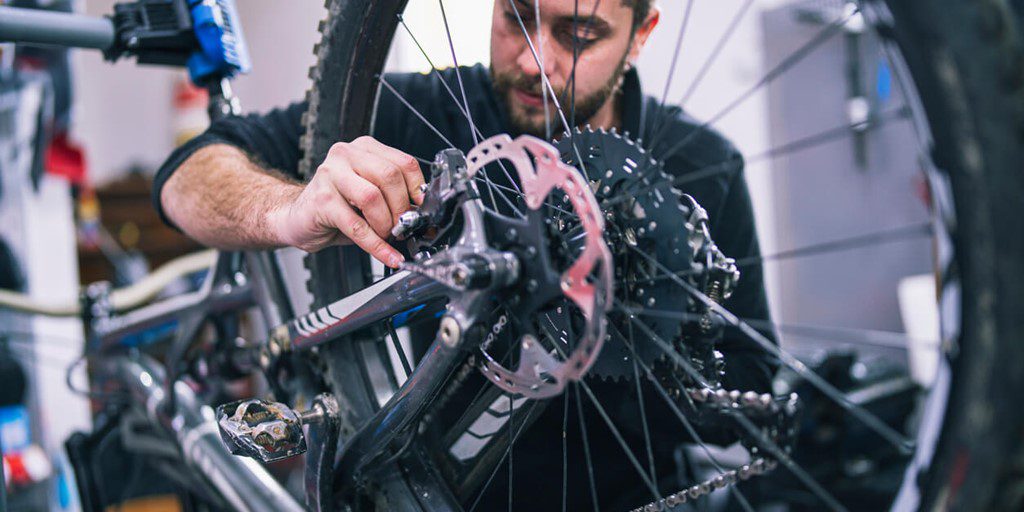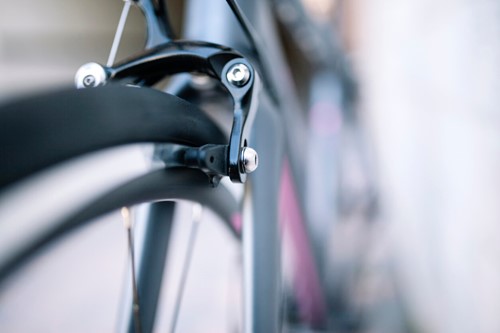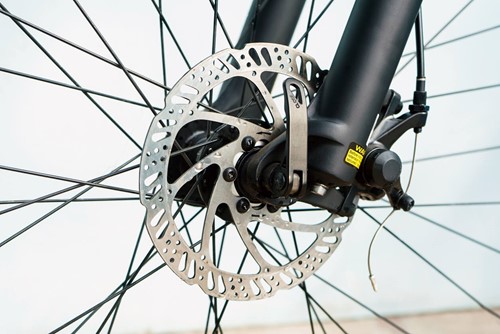How to stop bike brakes from squeaking (step-by-step)

Want to know how to stop your bike brakes from squeaking? We get it—it’s one of the most annoying issues that we cyclists run into.
While there’s no one-size-fits-all answer, we’ve covered every possible cause and the step-by-step process of elimination to follow when it comes to identifying the problem.
That way, you can get to the route of the issue causing squeaky brakes on your bike and get rid of it for good.
Table of contents
Why do my bike brakes squeak?
Squeaky bike brakes are a common issue amongst cyclists, but the good news is that they’re rarely difficult to fix. Once you know how to spot the cause, you’ll have your brake performance restored in no time.
It’s important to act fast if you experience this, as ignoring the issue could lead to an accident.
Outside of tell-tale signs specific to certain braking systems, there are a few common reasons behind noisy bike brakes:
Contamination via oil or grease
Grit or dirt obstructing brake function
Poorly set-up brakes
Worn brake pads
New brake pads that need wearing in
To properly diagnose the fault, it’s a good idea to understand each possibility before diving into your toolbox.
Related: How To Get Better At Road Cycling In 8 Simple Steps
Understanding rim brakes vs disc brakes
While there are a variety of bike braking systems out there, the two main categories they sit within are rim brakes and disc brakes.
It’s helpful to know the factors that cause the issue in each system before you investigate fixing your squeaky bike brakes. You can then rule out the more obvious solutions.
Rim brakes

Rim brakes, otherwise known as side-pull calliper brakes, work by pushing a set of pads against the wheel’s rim to slow its rotation.
They were once the most popular choice for road bikes. However, their popularity has dwindled slightly in recent years due to their inferior performance in wet weather compared to disc brakes.
The average rider will find rim brakes sufficient, especially since bike models that feature them are much less expensive than those that come with disc brakes. Their lightweight design also makes them the preferred choice for many cyclists.
When learning how to stop your bike brakes from squeaking, it’s good to know that a leading cause of more serious malfunctions in rim brakes is an incorrect set-up. Keep reading for how to fix this.
Related: How To Lock Your Bike Safely And Securely: Everything You Need To Know
Disc brakes

Disc brakes are used on most new bikes, whether they’re road bikes, hybrid bikes or mountain bikes.
They have been the go-to braking option for mountain bikes for years due to their ability to provide superior stopping power in all weather conditions.
Instead of pushing pads against the wheel’s rim, they are housed on its hub and press against a brake rotor or ‘disc’ at its centre.
Aside from the main causes of squeaky bike brakes, a common reason for this issue in disc brakes is the rotor bending out of shape. This then causes the brakes to be misaligned.
The bending happens through general wear and tear and can sometimes be rectified through reshaping it—but more on this below.
How to stop bike brakes from squeaking
Now that you understand the differences between rim and disc braking systems, you’ll have a keen eye when it comes to locating the problem behind your bike brakes squeaking.
But before you rush into action, check out our step-by-step process for how to stop bike brakes from squeaking.
Often, the issue is simply a case of dirty or contaminated brakes that need a quick clean, and it’s a good idea to try the simple methods first. But we’ve also covered how to fix the more pressing issues too.
Related: The 11 Best Cycling Routes In The UK
Rim brakes
Step 1 – Check if they’re clean
The first step of this process should always involve checking if any dirt, grit, or debris is caught underneath your brake pads.
Since the brake pads naturally wear down as you use them, these materials can easily become lodged in the available space, along with metal or rubber residue.
If your brake pads are caked with a layer of dirt and debris, their surface will be less effective at slowing the wheel rotation when it meets the rim.
Aside from the brake pads, you‘ll need to check the surface of the wheel rim that meets them, as well as the callipers. Dirt or debris can also restrict the effectiveness of your brakes and cause them to squeal as they strain to slow your bike.
How to clean dirty bike brakes:
Remove the wheels from your bike
Check for dirt on the brake pads and the surrounding areas
Use a cloth to carefully remove any initial clumps of dirt
Use a new cloth and some acid-free bike cleaner to remove stubborn dirt
Re-attach the wheels once the brakes and wheel rims are clean
Check if you still have squeaky bike brakes
NOTE: If the dirt looks as though it may be oil or lubricant (it usually has a greasy texture), you may need to use a degreaser to remove it. Contamination through heavy chain lubing is one of the most common causes of squeaky brakes!
Related: How To Easily Adjust Your Bike Brakes
Step 2 – Check the set-up of your brakes
Are your rim brakes misaligned? The easiest way to spot this is by applying the brake and checking how the pads and the wheel rims are meeting.
If it doesn’t look quite right, you can carefully loosen the mounting bolts and reposition the brake pads to ensure they’re making a strong connection with the rims.
Another fix is to toe in the brake pads. They are usually set up parallel to the wheel rims, but this process involves altering the pads, so their front section touches the rim first.
This gives the bike a more gradual braking system and lessens the chance of squeaky bike brakes.
How to toe-in your brake pads:
Place a standard piece of card between the brake pad and the rim
Apply your brakes to ensure it stays in place
Using an Allen key, loosen the bolt securing the callipers slightly (this resets the pad’s position)
Re-tighten the bolt and the process is complete!
Check out the video below for more help on doing this properly.
Step 3 – Check brake pad condition
If you haven’t done so already, you should inspect your brake pads for signs of wear and tear. If you’ve had them for a while, it could simply be that they’ve become worn, and it’s time to replace them.
We’d recommend researching the best type of brake pad to go with the material of your wheel rims, as this can make a huge difference in how accurate their connection is and how noisy your bike brakes are!
Ultimately, replacing your brake pads is a last resort to stopping your rim bike brakes from squeaking. If you go through the proper process of elimination when it comes to the cause of this issue, you shouldn’t experience it again after investing in a new set of pads.
Related: Why Do Cyclists Need Insurance?
Disc brakes
Step 1 – Check if they’re clean
The way disc brakes are positioned means they attract much less dirt than rim brakes do.
Since the rotors and disc brake pads are much tighter together, it’s less likely for dirt and debris to get caught between these surfaces.
Contamination through heavily lubing the chain is the most likely cause of unclean disc brakes, whether the brake pads or the rotor. So, this is useful to keep in mind before your next maintenance session.
To fix contamination on the rotor, you can simply:
Grab a cloth and some disc brake cleaner
Spray the cleaner directly onto the rotor
Wipe away any oil with the cloth
Things are a little trickier when fixing contamination on disc pads. To inspect them, you can:
Remove the wheels from your bike
Carefully remove the brake pads
Check the pads for oil and grease
If they are contaminated, you can try applying mud to the area once the brakes and wheels are re-attached and then braking hard. Sometimes this is enough to rectify the issue.
However, if this doesn’t work, you may need a vice and blow torch to boil the oil away. If you don’t own one, it can mean a trip to the bike shop.
Step 2 – Check if the pads or rotors are glazed
Leading on from the above point, if you check your disc brake pads and they’re not contaminated, they could be glazed over, along with the rotors they’re pressing against.
This means the braking surfaces have become worn down and smooth. It’s a natural result of repeated braking and happens to most cyclists using disc brakes once they’ve done a lot of miles on their bike.
You’ll need to return the rotors and pads to their rough state to resolve this issue.
For the rotors, you can:
Wipe them down using disc brake cleaner and a cloth
Grab some 150-grade sandpaper
Rub them gently in a circular motion
Change the sanding direction to up and down
Change the sanding direction to side to side
Continue until the surface is rough again
Using different sanding motions will help prevent the same issue from occurring in the future, as an uneven surface will make another glaze less likely to appear.
Once you’ve done that, here’s how to fix the pads:
Grab some 150-grade sandpaper
Place it on a flat and stable surface
Hold the pads firmly, and rub them against the sandpaper (face down)
Continue until the roughness returns to their surface
Related: The Ultimate Bike Maintenance Guide To Keep You Riding
Step 3 – Check the alignment of the callipers
To check the alignment of your callipers, place your bike in a stand and spin the front wheel.
If it spins freely and the callipers provide equal space on either side of the disc brake pads, they are aligned properly.
However, if the space is uneven and the wheel doesn’t move freely when you spin it, this could be your issue. Luckily, it’s an easy fix, and you should have no problem re-centring the callipers yourself.
With your bike still in the stand, you can:
Loosen the mounting bolts securing the callipers in place
Sharply apply the brakes, and re-tighten the bolts whilst doing so
Once you’ve done this, repeat the checking process with the back wheel.
Need to see this in action? Look at the video below.
Step 4 – Check if the rotors are bent
Another issue specific to disc braking systems is bent rotors.
It’s a good one to make yourself aware of when learning how to stop your bike brakes from squeaking, as it’s the most likely cause if re-centring your callipers didn’t work.
Place your bike in a stand and spin the front wheel to check for this issue. Observe how the rotor moves about the callipers and whether it remains in a straight position.
If it is bent, you can try to push it back into shape:
Grab an adjustable spanner
Fit it to the width of the rotor
Apply it to the bent area
Gradually use resistance to bend it towards its original position
You may find that this doesn’t work, and the rotor is too bent. In that case, you’ll need to replace it.
Specialist bike insurance from Cycleplan
There’s nothing worse than something going wrong with your bike, especially after investing so much money. Give yourself peace of mind by getting your bike and accessories covered through bike insurance.
At Cycleplan, our specialist cycling insurance protects your bike and accessories against theft, loss, and accidental damage up to the value of £30,000. We also offer personal accident cover, public liability, and other additional policies.
Click here to discover how our specialist cycling insurance can help you and get an instant online quote today.
Related
The 10 Best Cycling Accessories For All Abilities
How To Fix A Bike Puncture In 9 Simple Steps
What Are The Most Common Cycling Injuries?







